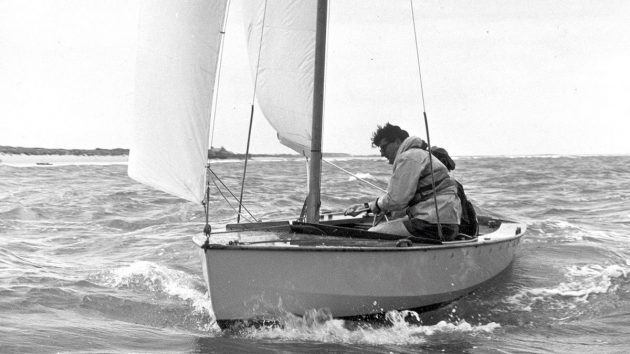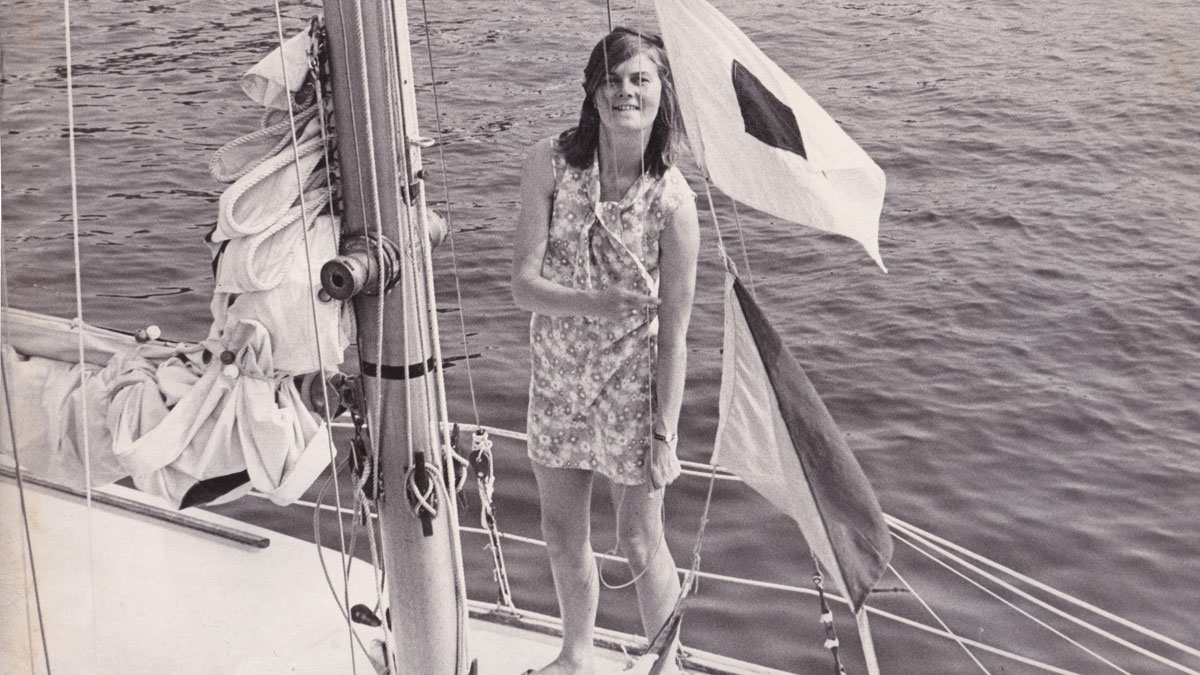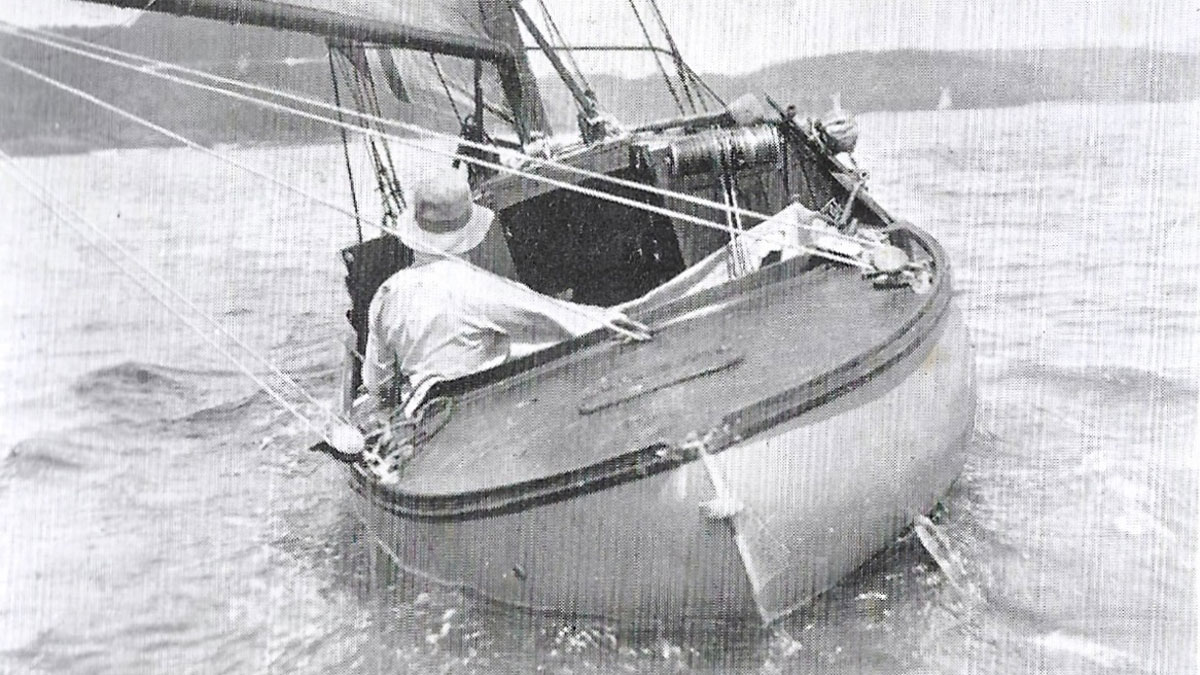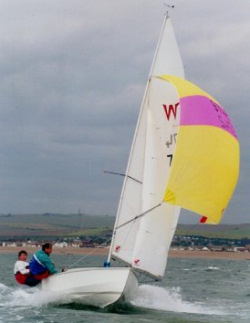Roger Barnes reflects on the legacy of small-boat sailors Margaret and Frank Dye
“By 2015 it was Bill’s watch, and the seas were bad, at least 30ft (9.14m) and very heavy,” wrote Frank Dye.
“Suddenly a real bad one roared down on us from the port side, and crashed in. Roaring right over us, it rolled us over. I had a fleeting memory of being thrown clean out of the stern, seeing Bill going under me, then the boat coming down on me. Down I went into the green depths with tremendous weight driving me downwards.”
Fortunately, the two crewmembers were attached to their vessel with lifelines, so they managed to swim clear of the upturned hull, right their boat and then scramble back aboard, only for her to be rolled over one more time.
“It was now quite impossible to look into the wind. It was screaming, and the tops of the waves were blown completely away, hitting one’s body, and feeling like hail. Within our limited vision the whole sea seemed to be smoking. Entire waves were breaking in a wall of solid water with tremendous roars.” (Ocean Crossing Wayfarer, Frank & Margaret Dye: 2nd edition, Adlard Coles, 2006).

Frank Dye navigating in his 16ft open Wayfarer dinghy on the way to Iceland; he found it “challenging” at times. Credit: Photos © Frank and Margaret Dye 1977, as reproduced in Ocean Crossing Wayfarer: To Iceland and Norway in a 16ft Open Dinghy published by Adlard Coles (www.adlardcoles.com) unless stated
Frank Dye and Bill Brockbank had set out in a Wayfarer dinghy from Kinlochbervie in Sutherland in July 1964, and sailed north-west into the Atlantic Ocean.
They stopped briefly in a bleak anchorage on the uninhabited island of North Rona to cook and eat a square meal to compensate for Bill’s incessant seasickness, then sailed on for the Faroes, finding their way to the distant archipelago by RDF and sextant: all this in a wooden dinghy less than 16ft (4.8m) long, with no cabin and an open cockpit.
They rested in the Faroes for three days, then departed on a 450-mile crossing of the Norwegian Sea. It was to be a 10-day passage.
The two men stood alternate watches of three hours in good weather and shorter ones when it was rough.
The ‘watch below’ lay on the bottom boards to sleep, with their legs thrust under the main thwart and a sheet of canvas fixed to the back of the foredeck to protect their head from spray.

Sailing Wanderer downwind with the jib and genoa goose winged. Credit: Photos © Frank and Margaret Dye 1977, as reproduced in Ocean Crossing Wayfarer: To Iceland and Norway in a 16ft Open Dinghy published by Adlard Coles (www.adlardcoles.com) unless stated
Although the motion was often violent, they managed to cook hot meals on a gimballed petrol stove, clamped to the thwart.
On the leg to Norway, the Wayfarer endured four successive gales, and Bill was repeatedly seasick.
When the wind became too strong to sail, they lay to a drogue with the Wayfarer’s tall mast lowered into crutches, and a cover lashed over the front of the cockpit to protect them from the wind and the spray.
The wind rose to a Force 9 that capsized the dinghy several times.
Each time they were rolled, they risked being trapped under water by the cover.
Finally, the wind lessened, but by then the two men had lost most of their tools, much of their food and all their dry clothing, and they were still 200 miles off the Norwegian coast.

Wanderer was sailed along most of the UK’s North Sea coasts and had crossed from Scotland to Bergen before Frank Dye and Russell Brockbank sailed to Iceland in 1963. Credit: Photos © Frank and Margaret Dye 1977, as reproduced in Ocean Crossing Wayfarer: To Iceland and Norway in a 16ft Open Dinghy published by Adlard Coles (www.adlardcoles.com) unless stated
The wooden mast had been broken in one of the knockdowns and the warp of their sea anchor had parted.
They threw the boom with the mainsail wrapped round it over the side as a makeshift drogue, while they baled the boat and debated what to do next.
A ship appeared on the horizon, and they let off some flares, but she steamed on without noticing their distress signals.
Cold, shivering and wet, they lashed the two longest pieces of the mast together to create a spar long enough to set the genoa.
Continues below…
The pioneering sailor you’ve probably never heard of: Nicolette Milnes Walker
Nicolette Milnes Walker was the first woman to sail solo and non-stop from the UK to the USA. Julia Jones…
Frank Cowper: the sailor who “invented” cruising
Katy Stickland talks to Frank Cowper’s great granddaughter about the life and legacy of this unsung pioneer of yachting for…
The Wayfarer dinghy – 50 years on
Poole Harbour to host events celebrating half a century of the Wayfarer dinghy
Best daysailers: All thrills, no frills with these compact craft
You can learn a lot from studying famous sailors and what they say. Take Uffa Fox, for example. As well…
Under this jury rig, they ran on towards Norway, all the while filming their passage on a 16mm cine camera.
Their grainy and scratchy film Summer Cruise is available on YouTube, and it is an astonishing watch.
When Frank and Bill arrived safely in Norway, Bill had lost 18lb (8kg) in weight due to his persistent seasickness on passage.
Their adventure has been compared to Shackleton’s open boat passage to South Georgia, while others consider it reckless.
It was not a one-off for Frank Dye, however.
The passage was his fourth crossing from Scotland to Norway, and the previous year he’d taken his Wayfarer on the longer passage from Scotland to Iceland, with a different crew.

Wanderer is now on display in the National Maritime Museum in Falmouth. Credit: Doug Sim/Wikimedia Commons
All Frank’s trips were meticulously planned, following a detailed study of almanacs, charts and pilot books, as well as meteorological records and sea temperatures.
His passages were certainly daring, testing the ability of the Wayfarer and of his various crews to the limit, but he was fastidious in his methods.
Frank Dye (1928-2010) remains perhaps the most celebrated proponent of cruising in an open dinghy.
He showed what can be achieved with modest means, when coupled with extraordinary ambition.
A motor car dealer from Norfolk, he had little experience of sailing when he ordered one of the first Wayfarer dinghies, after seeing the lines of Ian Proctor’s design in a yachting magazine.
“If it looks right, it is right,” he said later in conversation with the Dinghy Cruising Association’s Johnny Adams, “and the Wayfarer is a pretty-looking boat. It was the only thing I ever bought without seeing or trying. I just fell in love with it.”

Frank and Margaret Dye’s adventures have inspired thousands of other sailors including Jeremy Warren, who circumnavigated the UK with crew on his Wayfarer, Hafren. Credit: Miranda Delmar-Morgan
When Proctor designed the Wayfarer in 1957, he aimed to create a dinghy with the all-round ability of the traditional knockabout dinghies of the pre-war years, while exploiting the potential of modern plywood construction.
The Wayfarer was conceived as a stable cruising boat that would be no slouch when racing. Frank Dye saw great possibilities in the design, believing that it would be capable of serious open water passages.
The Wayfarer that Frank ordered was built professionally by Small Craft of Southampton, and she was sail number 48 in the class.
He named her Wanderer, and immediately started on a series of passages in the North Sea, beginning with cruises between harbours on the North Norfolk coast close to his home, then graduating to serious open water crossings.
By the time he was asked to display Wanderer at the London Boat Show, he had already made several passages from Scotland to Bergen in Norway, a distance of 300 miles.
While sitting in Wanderer at the boat show, Frank met his future wife and long-term sailing companion Margaret, but their initial encounter didn’t go particularly well:
“It was definitely love at first sight. It was the spring of 1963 and Wanderer was sitting inconspicuously in a corner of the Earl’s Court Boat Show…. Her varnished decks were salt-crusty and scarred. Inside, old stained sails, warps, piles of worn crumbled charts, Wellington boots and anchors lay on her smelly floorboards. On the thwarts sat a small dark-suited man reading a book; he barely glanced up as people crowded around the Wayfarer dinghy – and he answered questions in a shy, diffident manner… Eventually I plucked up enough courage to ask if women crew were ever required. The answer was an emphatic ‘No!’” (Sailing to the Edge of Fear by Frank and Margaret Dye, A&C Black, 2000).

Margaret and Frank Dye wrote about their experiences in Ocean Crossing Wayfarer
Keen to go sailing anyway, Margaret attended a sailing course the next summer – where she encountered Frank Dye again.
“Don’t sail with that man, he’ll kill you,” said the instructor. Margaret ignored the advice, and soon became a regular crew on Frank’s weekend cruises along the East Anglian coast and across the Wash.
They discussed their summer holiday that year aboard Wanderer.
Margaret suggested trailing her to the Venetian lagoon and visiting art galleries and churches.
Frank’s love of exposed northern waters prevailed however, so they went to the remote archipelago of St Kilda instead, racing back towards the Sound of Harris on their return, surfing off the faces of the Atlantic rollers, trying to identify the buoys in the sinuous passage between Harris and North Uist.
The experience didn’t put Margaret off at all, and soon they were married.
The couple’s honeymoon was a December cruise off the coast of Devon.
“The sailing was good, but never before had I known what it was to be so cold,” Margaret recounted.
If Frank’s passages with his new wife were less ambitious than with his previous male crews, they were still impressive by normal people’s standards.
The couple mixed daysails in their Norfolk home waters with longer holiday cruises, using their dinghy to the limit.
Sometimes they trailed their dinghy to a sailing area that interested them or they shipped her abroad in a container.
Cruises included visits to Fair Isle, to the Lofoten Islands on the Norwegian coast, and a series of passages along the east coast of North America.

The Dye’s beloved dinghy, Wanderer
The Dyes progressively refined the living accommodation aboard Wanderer, christening their final over-boom tent ‘The Hilton Hotel’.
It had vertical sides and full sitting headroom throughout, and Margaret’s eyes always lit up whenever she described their time aboard the dinghy, the places it had taken them to and the experiences they’d enjoyed. She wanted for nothing more.
I first met Frank and Margaret in 2001, when they gave a talk to the Dinghy Cruising Association, and I was struck by how modest and straightforward they were.
This was not a pair of reckless adventurers, but simply a couple who enjoyed sharing quality time together in the wild.
Later, I met them every year exhibiting at the Beale Park Boat Show.
They’d sit by the lake beside one of a series of Wayfarers that replaced the original Wanderer, talking with enthusiasm about dinghy cruising.
On the first evening of the show, Margaret would tour the other boats, secretly putting bouquets of wildflowers on the ones she approved of, and nothing at all on the boats she didn’t.
By that stage, the original Wanderer had been preserved for the nation in the National Maritime Museum’s collection in Falmouth.
In later years, Frank Dye took a more modern Wayfarer single-handed all the way up the east coast of the USA, while Margaret looked for a smaller boat she could sail alone, which would suit her slim frame.
Proctor designed a special version of his smaller Wanderer design for her, called the Wanderer MD, and she would often be seen sailing the dinghy on the Norfolk Broads, camping aboard in quiet anchorages among the reeds.
The Dyes are most famous for their ambitious open water passages, which were a great influence on later sailors.
But surely the Dyes’ greatest achievement is displaying the potential of a simple cruising dinghy for a lifetime’s pleasurable sailing.
They cruised dinghies all their lives together, and never aspired to own a larger and more pretentious vessel.
They understood that sailing is all about the experience: it is about simple pleasures like awakening with the noise of the waves gently lapping at your dinghy’s hull, then opening the tent doors and looking out at the sun rising over a new anchorage.
Buy Ocean Crossing Wayfarer: To Iceland and Norway in a 16ft Open Dinghy at Amazon (UK)
Buy Ocean Crossing Wayfarer: To Iceland and Norway in a 16ft Open Dinghy at Amazon (US)
Buy Ocean Crossing Wayfarer: To Iceland and Norway in a 16ft Open Dinghy at Waterstones (UK)
Buy Ocean Crossing Wayfarer: To Iceland and Norway in a 16ft Open Dinghy at Foyles (UK)
Buy Ocean Crossing Wayfarer: To Iceland and Norway in a 16ft Open Dinghy at Google Play
Note: We may earn a commission when you buy through links on our site, at no extra cost to you. This doesn’t affect our editorial independence.
Enjoyed reading Margaret and Frank Dye: open boat pioneers? 
A subscription to Practical Boat Owner magazine costs around 40% less than the cover price.
Print and digital editions are available through Magazines Direct – where you can also find the latest deals.
PBO is packed with information to help you get the most from boat ownership – whether sail or power.
-
-
-
- Take your DIY skills to the next level with trusted advice on boat maintenance and repairs
- Impartial in-depth gear reviews
- Practical cruising tips for making the most of your time afloat
-
-








